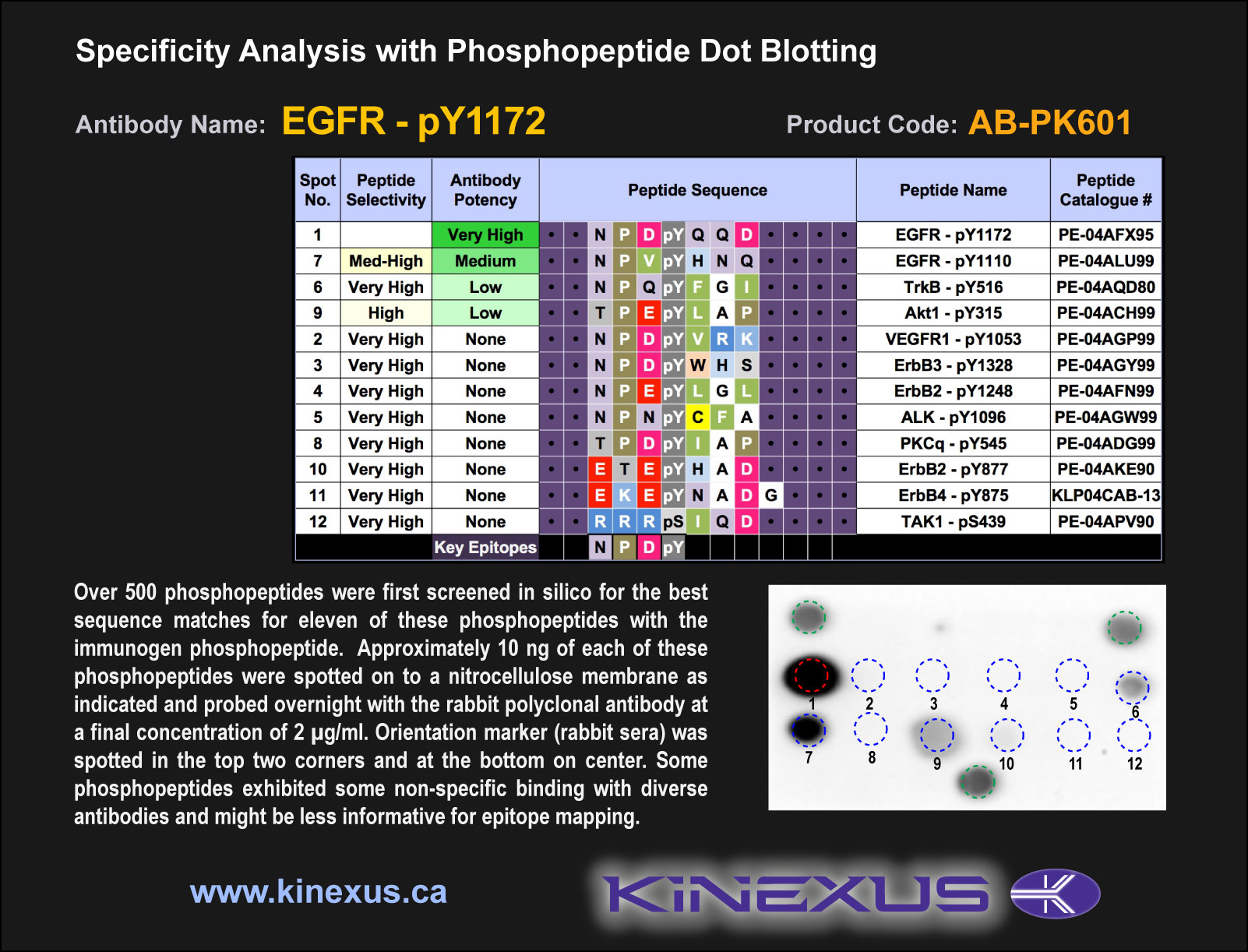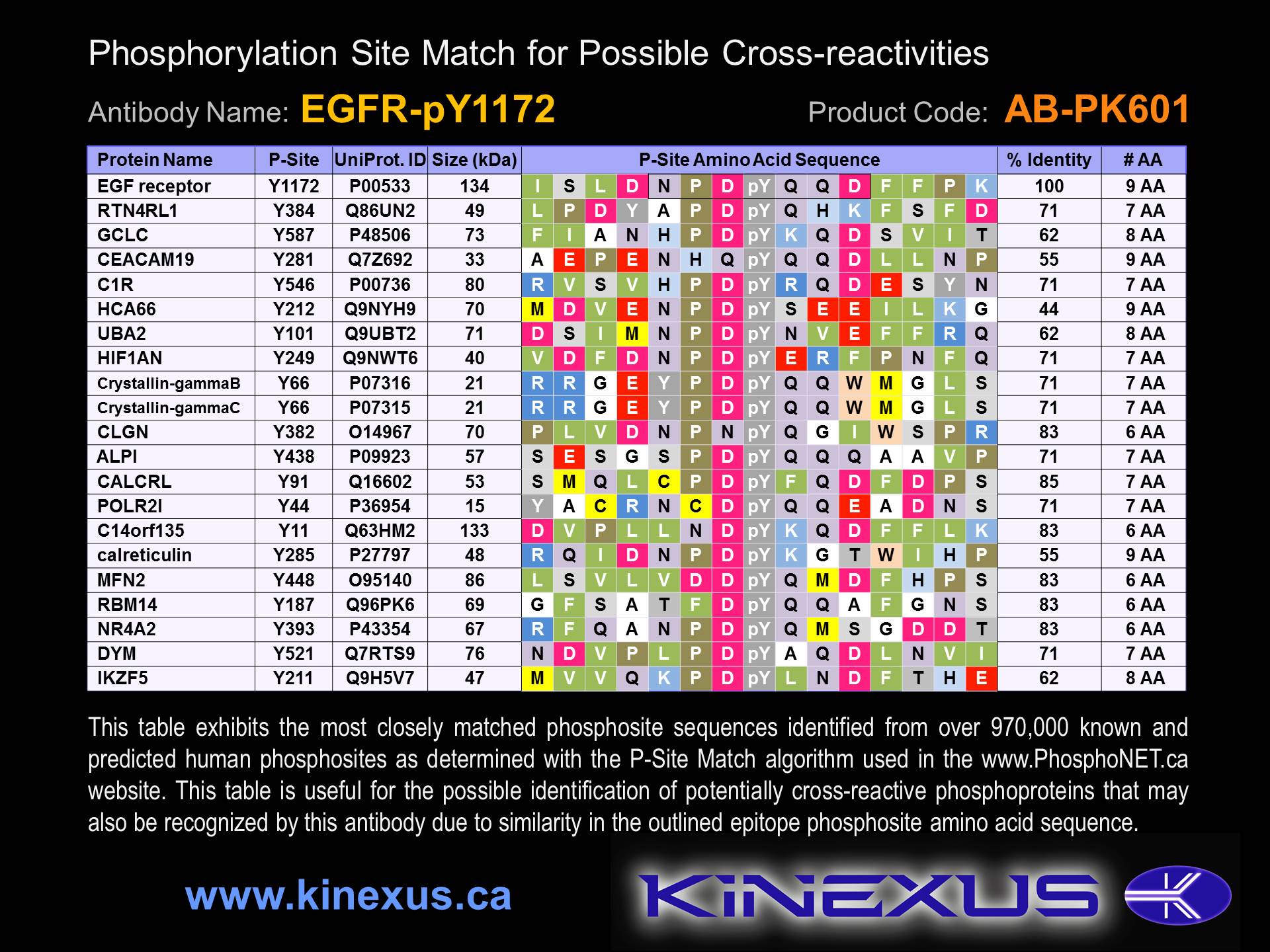Product Name: EGFR-pY1172
Product Number: AB-PK601
| Size: | 25 µg | Price: | 89.00 | |
| $US |
Target Full Name: Epidermal growth factor receptor-tyrosine kinase
Target Alias: EGFR; Epidermal growth factor receptor; ErbB-1; ErbB, mENA; HER1; Receptor tyrosine-protein kinase ErbB-1; V-erb-b oncogene homologue; PIG61; CCDS5514.1; ENSG00000146648
Product Type Specific: Protein kinase phosphosite-specific antibody
Antibody Code: PK601
Antibody Target Type: Phosphosite-specific
Antibody Phosphosite: Y1172
Protein UniProt: P00533
Protein SigNET: P00533
Antibody Type: Polyclonal
Antibody Host Species: Rabbit
Target Alias: EGFR; Epidermal growth factor receptor; ErbB-1; ErbB, mENA; HER1; Receptor tyrosine-protein kinase ErbB-1; V-erb-b oncogene homologue; PIG61; CCDS5514.1; ENSG00000146648
Product Type Specific: Protein kinase phosphosite-specific antibody
Antibody Code: PK601
Antibody Target Type: Phosphosite-specific
Antibody Phosphosite: Y1172
Protein UniProt: P00533
Protein SigNET: P00533
Antibody Type: Polyclonal
Antibody Host Species: Rabbit
Antibody Immunogen Source: Human EGFR (ErbB1) sequence peptide Cat. No.: PE-04AFX95
Antibody Immunogen Sequence: NPD(pY)QQD(bA)C
Antibody Immunogen Description: Corresponds to amino acid residues N1169 to D1175; In the C-terminal of the kinase after the catalytic domain
Antibody Immunogen Sequence: NPD(pY)QQD(bA)C
Antibody Immunogen Description: Corresponds to amino acid residues N1169 to D1175; In the C-terminal of the kinase after the catalytic domain
Production Method: The immunizing peptide was produced by solid phase synthesis on a multipep peptide synthesizer and purified by reverse-phase hplc chromatography. Purity was assessed by analytical hplc and the amino acid sequence confirmed by mass spectrometry analysis. This peptide was coupled to KLH prior to immunization into rabbits. New Zealand White rabbits were subcutaneously injected with KLH-coupled immunizing peptide every 4 weeks for 4 months. The sera from these animals was applied onto an agarose column to which the immunogen peptide was thio-linked. Antibody was eluted from the column with 0.1 M glycine, pH 2.5. Subsequently, the antibody solution was neutralized to pH 7.0 with saturated Tris.This antibody was also subject to negative purification over phosphotyrosine-agarose.
Antibody Modification: Unconjugated. Contact KInexus if you are interest in having the antibody biotinylated or coupled with fluorescent dyes.
Antibody Modification: Unconjugated. Contact KInexus if you are interest in having the antibody biotinylated or coupled with fluorescent dyes.
Antibody Concentration: 1 mg/ml
Storage Buffer: Phosphate buffered saline pH 7.4, 0.05% Thimerasol
Storage Conditions: For long term storage, keep frozen at -40°C or lower. Stock solution can be kept at +4°C for more than 3 months. Avoid repeated freeze-thaw cycles.
Product Use: Western blotting | Antibody microarray
Antibody Dilution Recommended: 2 µg/ml for immunoblotting
Antibody Potency: Strong immunoreactivity of a target-sized protein by Western blotting in EGF-treated A431 cells (SDS-PAGE buffer extracted). Very strong immunoreactivity with immunogen peptide on dot blots. Very strong immunoreactivity with recombinant human EGFR on protein dot blots.
Antibody Species Reactivity: Human
Storage Buffer: Phosphate buffered saline pH 7.4, 0.05% Thimerasol
Storage Conditions: For long term storage, keep frozen at -40°C or lower. Stock solution can be kept at +4°C for more than 3 months. Avoid repeated freeze-thaw cycles.
Product Use: Western blotting | Antibody microarray
Antibody Dilution Recommended: 2 µg/ml for immunoblotting
Antibody Potency: Strong immunoreactivity of a target-sized protein by Western blotting in EGF-treated A431 cells (SDS-PAGE buffer extracted). Very strong immunoreactivity with immunogen peptide on dot blots. Very strong immunoreactivity with recombinant human EGFR on protein dot blots.
Antibody Species Reactivity: Human
Antibody Positive Control: The observed molecular mass of the processed target protein on SDS-PAGE gels is reported to be around 160-180 kDa.
Antibody Specificity: Very high
Antibody Cross Reactivity: Medium immunoreactivity on protein dot blots with recombinant human ErbB2, but not ErbB4. No significant cross-reactive proteins detected in A431, A549 and MCF7 cells, except for an EGF stimulated 75 kDa cross-reactive protein in A431 cells.
Related Product 1: EGFR-pY1172 blocking peptide
Related Product 2: EGFR-pY869 phosphosite-specific antibody (Cat. No.: AB-PK602)
Related Product 3: EGFR-pY998 phosphosite-specific antibody (Cat. No.: AB-PK603)
Antibody Specificity: Very high
Antibody Cross Reactivity: Medium immunoreactivity on protein dot blots with recombinant human ErbB2, but not ErbB4. No significant cross-reactive proteins detected in A431, A549 and MCF7 cells, except for an EGF stimulated 75 kDa cross-reactive protein in A431 cells.
Related Product 1: EGFR-pY1172 blocking peptide
Related Product 2: EGFR-pY869 phosphosite-specific antibody (Cat. No.: AB-PK602)
Related Product 3: EGFR-pY998 phosphosite-specific antibody (Cat. No.: AB-PK603)
Related Product 4: EGFR-pY1069 phosphosite-specific antibody (Cat. No.: AB-PK599)
Related Product 5: EGFR-pY1110 phosphosite-specific antibody (Cat. No.: AB-PK600)
Related Product 6: EGFR pan-specific antibody (Cat. No.: AB-NK052-3)
Related Product 7: EGFR-1 pan-specific antibody (Cat. No.: AB-NK052-5)
Related Product 8: EGFR-3 pan-specific antibody (Cat. No.: AB-NK052-4)
Related Product 9: EGFR-4 pan-specific antibody (Cat. No.: AB-NK052-7)
Related Product 10: EGFRSubtide - EGFR protein kinase substrate peptide
Related Product 5: EGFR-pY1110 phosphosite-specific antibody (Cat. No.: AB-PK600)
Related Product 6: EGFR pan-specific antibody (Cat. No.: AB-NK052-3)
Related Product 7: EGFR-1 pan-specific antibody (Cat. No.: AB-NK052-5)
Related Product 8: EGFR-3 pan-specific antibody (Cat. No.: AB-NK052-4)
Related Product 9: EGFR-4 pan-specific antibody (Cat. No.: AB-NK052-7)
Related Product 10: EGFRSubtide - EGFR protein kinase substrate peptide
Scientific Background: EGFR (ERBB1, HER1) is a protein-tyrosine kinase of the TK group and EGFR family. EGFR regulates cell proliferation, division, motility, survival, and has other roles in tissue development. It is activated by binding epidermal growth factor (EGF) and transforming growth factor-alpha (TGFa), which induce dimerization and autophosphorylation. Phosphorylation of Y270 stimulates interaction with EGFR. Phosphorylation of Y869 increases phosphotransferase activity and induces interaction with COX2. Phosphorylation of Y1016 increases phosphotransferase activity and induces interaction with GrbB2, PLCg1, PTPN11 (SHP2), RasGAP, and Vav2. Phosphorylation of Y1069 increases phosphotransferase activity and induces interaction with Cbl. Phosphorylation of Y1092 induces interaction with PLCg1, PTPN6 (SHP1) and Ras-GAP. Phosphorylation of Y1110 induces interaction with Ras-GAP. Phosphorylation of Y1172 increases phosphotransferase activity and induces interaction with Dok1, EGFR, RasGAP, PTPN11 (SHP2), and Vav2. Phosphorylation of Y1197 increases phosphotransferase activity and induces interaction with Cbl, EGR, PLCg1, RasGAP, SH3KBP1, Shc1, and PTPN6 (SHP1). EGFR is inhibited by phosphorylation at T678,S695 and S1026. Phosphorylation of T693, S695, S1070, S1071, and S1190 contributes to receptor internalization. EGFR is a known oncoprotein (OP). Cancer-related mutations in human tumours point to a gain of function of the protein kinase. Constitutive activation of EGFR kinase activity has been seen with the mutations of V689M, E1005R+D1006K. The active form of the protein kinase normally acts to promote tumour cell proliferation.
Figure 1. Epitope mapping of EGFR-pY1172 antibody with similar phosphopeptides on dot blots.
Figure 2. Identification of phosphosites related to EGFR-pY1172.
© Kinexus Bioinformatics Corporation 2017



